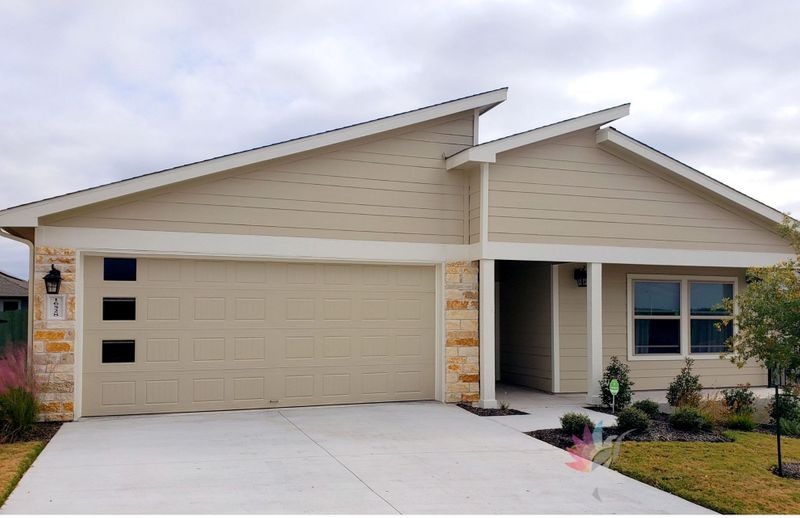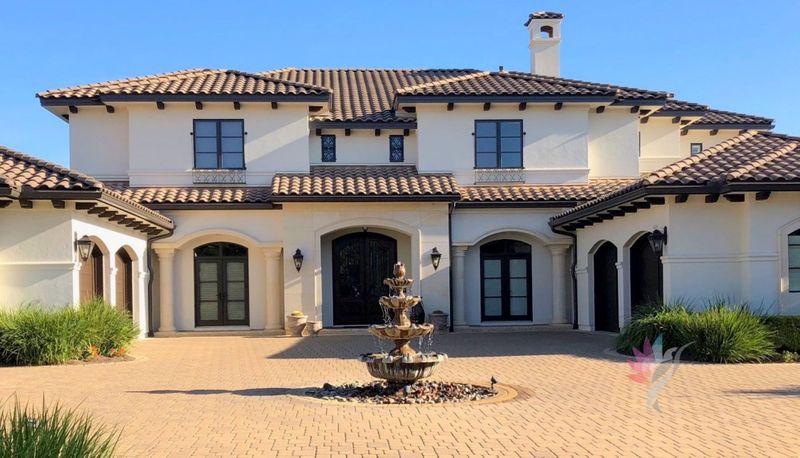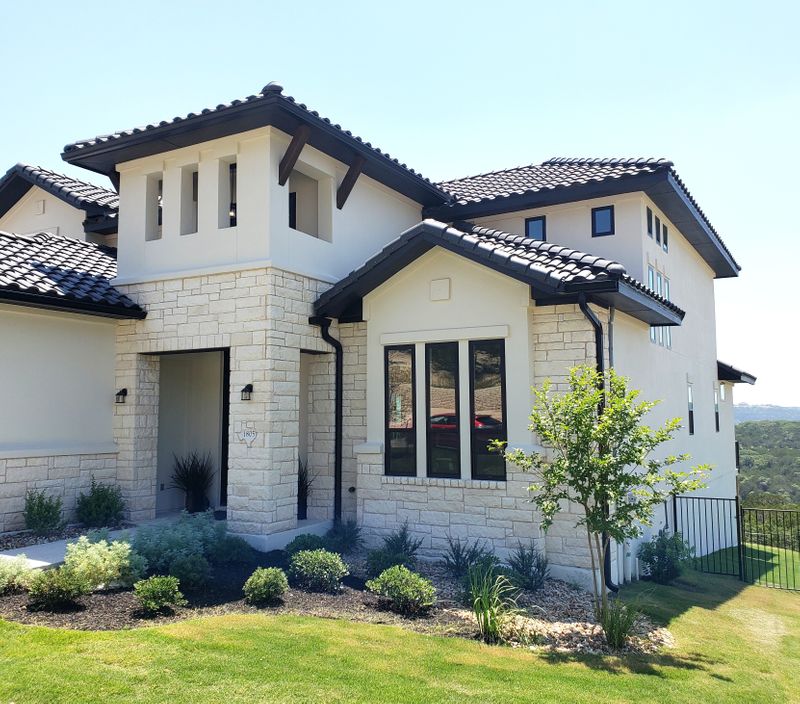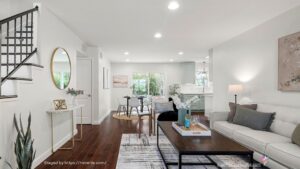Updating your home’s exterior with a fresh coat of paint is a task many homeowners will undertake with spring approaching and is undoubtedly one of the most important factors to consider when it comes to enhancing your home’s curb appeal. And there’s no wonder why exterior paint colors are important – they can make or break a potential homebuyer’s perception of your home.
With so many paint colors, finishes, and factors to consider when undertaking an exterior paint update, choosing a paint color can seem like an intimidating decision to make. To help ease the stress that comes with such a big design decision, we asked paint color experts from Austin, TX all the way to Warrenton, VA for their best exterior house painting tips to make your painting project a breeze.
1) Start with the Rule of 3
Start by choosing 3 coordinating colors. From there, choose a darker color than you initially think; the sun washes colors out quite a bit, so take the time to paint samples on a large sample board. I like to use the 20×30 poster board you can get at any craft store. –Nest Obsessed Interior Design
2) Simplify the process
Use a 3-step process to tackle your exterior paint project:
- Select colors that complement the period of your home.
- Divide your home into 3 sections when selecting paint colors: Siding color, Trim color, Door and/or Shutter color
- Then, place the samples at the front of your home, or on an area where you can see all three paint selections working together, and observe them during different times of the day –CPB Designs
3) Be mindful of lighting
It’s always best to paint large samples on the building before you start painting and look at the swatches at different times of the day. Keep this exterior house painting tip in mind if you’re choosing a white paint color for your home exterior. Off-whites can come across as a stark white when painted outside, and grays tend to turn bluish due to the lighting, so it’s best to choose a gray with some yellow in it. Remember, you can always go deeper in color hues on the exterior compared to interiors. –Catalina Paints
4) Keep it minimal
Narrow your exterior color choices down to only two colors: body color and trim color. The stone and roof colors will make up the rest of the palette,but be sure that there’s a definite contrast between the two colors. If your trim color is going to be white, be sure to avoid any pink or yellow undertones. Choose the most neutral white you can get. The best way to determine the undertones is to compare a few samples to each other, such as using paint chips from the store and place them on a white background under good light, preferably exterior, to see the undertones and eliminate any visible whites with color to it.
Any color painted on an exterior surface will be much lighter because of the exposure to daylight, so when you choose your darker color, don’t be afraid to choose a deeper value (darker shades) to ensure that the color doesn’t “wash out.” – Max Ruthven Color & Design
5) When in doubt, test it out
Be sure to sample for the ‘true color’ (how the paint color will ultimately read) of the paint you choose. Use the exterior house painting tip to get the true color for your sample by priming large portions on two sides of your house. When testing color samples, don’t put a sample over the existing color as it will “shift” the color, and don’t paint samples right next to each other. Having two colors side by side can cause them to “shift,” which can change our perception. And, when testing your samples, do two coats. Buy a quart (not the sample pint), so you can sample both the sheen and grade of paint- these both can change how the color reads on your home’s exterior. –Luxury Color Design
6) Don’t rely solely on the paint chips
One huge mistake while selecting exterior colors is to choose colors that are too light. What looks perfect on a color chip will appear much lighter in natural light. An exterior house painting tip to avoid this mistake is to always find your perfect color and go one to two shades darker. –The Business of Color

7) Consider the altitude of your house
Moisture softens colors, so a good exterior house painting tip to keep in mind is to choose a less vibrant color if you are at a higher elevation. The higher you are, the less water vapor is in the air. For example, if you live in Denver and want a yellow house, look at buttery tones instead of lemon ones. –The Color Psychic
8) Use your home’s history to your advantage
The history of your home can actually make it easier to choose a paint palette, as many paint brands are featuring collections that are “historic,” which can help narrow down your choices. Take a moment to research the decade your home was built, and you will find amazing paint color choices that you might not have ever considered. Whether your home is a mid-century ranch or a Victorian three-story beauty, there are swatches out there that will enhance your home’s charm and make it the talk of the neighborhood. –Splendid House Interiors
9) Take cues from your neighborhood
Identify your home’s style and neighborhood, existing elements of your home’s exterior, and nature around the home. Taking the time to survey your neighborhood will help you eliminate colors that not only won’t work for your home but also keep your neighbors happy. –Georgio Savva
10) Play around with accent colors
Add some personality with accent colors on your front door or shutters and paint the siding or larger planes of the house in a more neutral color. Take a hint from London or Paris, where most homeowners paint their doors in unique colors to make them stand out. It showcases the personality of the people who live there and is also easy to change when you are ready for a new hue. –Christine Billings Interior Design
11) Examine the fixed elements on your home
Look at colors independently or against the fixed elements (brick /stone) on the home. Don’t compare paint color choices next to one another but look at them independently on large painted sample boards in the exterior environment. –Your Color Consultant
12) Take inspiration from existing masonry
Use the existing roof and other accent materials like brick or stone to choose the color. These are often the hardest materials to change, so build the colors around that. We also love to pick one tone and play with multiple different saturations of that color to create unity and depth. –Frederick James Designs
13) Strike a balance with a neutral color palette
No matter the style of the house, you can’t go wrong with a palette of monochromatic neutrals. Look to any stone or brickwork as your color guide. Using the same paint color strip, select two of the mid-to-lighter tones. The trim color can be either the lighter or darker tone, and the body of the house the other. Use a black/dark color for the window rails, sashes, and grills for a sophisticated, updated look. The doors can be either the dark color of the window grills or a choice that introduces the color scheme found inside the house. –America’s Color Consultants
14) Pick colors that compliment permanent fixtures
The right exterior paint color depends on which elements are staying. If your home has a stone facade, select a paint color that compliments the stone with a similar undertone. By doing this, your home will have a cohesive color palette and will look beautiful. If your roof is brown, select a paint color with a warm tone, such as a soft creamy white. A black or charcoal roof provides the most versatile paint color options and works well with blue, grey, and white. –Styled Interiors

15) Familiarize yourself with the color wheel
Pick 2 to 3 colors that you love and match them to the rest of the home’s exterior. Once the colors have been chosen, they can be customized by reducing or mixing them with another base color. When we do either of these options, it’s always onsite at the home in a small sample section to see how it looks against the rest of the selections. This helps the client get a unique color. –Yvonne Christensen Design
16) Pay attention to tone
It’s important to find a color that has tone added to the pigments. Tone is adding gray to the pigments, which results in making the intensity of the color duller. This helps the color from being degraded from the Texas UV. Also, move down the monochromatic scale to a darker version of the color preferred. The color will often look lighter when applied in direct sun. – Clement’s Paint
17) Use color charts as references
I tend to select colors off historical color charts, as they are often more architecturally appropriate for exterior usage. One of my favorite ways to select an exterior paint color is to drive around town and identify existing homes that resonate with the look we hope to achieve. Then I knock on the door, express my admiration for their beautiful home, and politely ask if they wouldn’t mind sharing the color. Sometimes going the old-fashioned way is the best exterior house painting tip. –Salt Design Co.
18) Not sure where to start? Ask for an expert’s opinion
Hiring a professional color consultant can save you time and money. While it may not seem like it at first, buying paint samples can add up, and making a mistake that could require a repaint can be expensive.
Receiving exterior house painting tips on trends, styles, and the impact lighting has on your color choices are huge benefits of hiring an expert. –Ashford Painting






3 thoughts on “18 Must-Know Exterior House Painting Tips From Experts”
I will be renovating my house in La Mesa next month and I plan to start the project with a new paint job for the exterior first. I appreciate your tip when you told us to start with the rule of three, wherein we choose 3 coordinating colors before choosing a darker color than we initially thought since the sun can wash the color out quite a bit. I’ll keep this in mind while I look for a professional painter in La Mesa to hire for my home exterior soon.
Hi Clare, glad you found this article helpful! Let me know how it turns out! Sorry for the late reply. I just had my website moved over to this platform and allowing comments 🙂
It’s good that you advised us to be mindful of lighting when we paint our home exterior since there are colors that come out differently when painted outside. I will be renovating my house in Longview this spring, and I plan to start it with a new paint job first for the exterior. I’ll take note of this while I call a licensed painting company in Longview to hire for help soon.